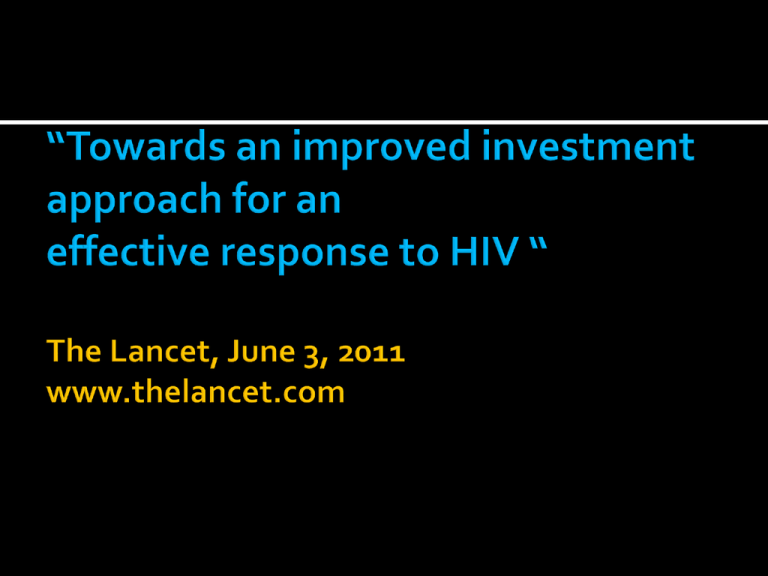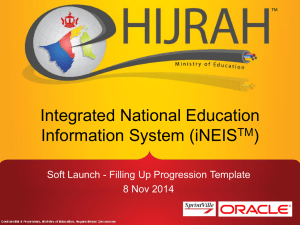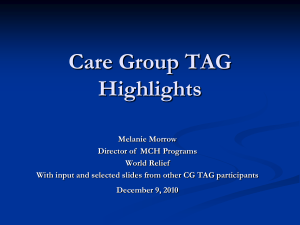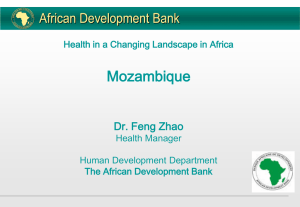
Six basic programmatic activities
Critical interventions that create an
enabling environment for achieving
maximum impact; and
Programmatic efforts in wider health
and development sectors related to
AIDS.
Rights-based approach to all services
and policies
Activities that have a direct impact on
reducing HIV transmission, morbidity and
mortality to be scaled up according to size of
relevant affected population
Based on high level evidence of effectiveness.
Treatment, care and support
Vertical Transmission prevention
Condom procurement and distribution
Key populations programs (MSM, IDU, Sex
Workers)
Male circumcision
Behavior Change programs
Social Enablers - make possible environments
conducive for sound AIDS responses:
outreach for HIV testing
Linkage from testing to care
treatment literacy
stigma reduction
advocacy to protect human rights
monitoring of the equity and quality of
programme access and results
Program Enablers - create demand for and help
improve the performance of key interventions:
incentives for engagement in health services
methods to improve retention on ART
capacity building for community-based
organizational development
strategic planning
communications infrastructure
information dissemination
efforts to improve service integration and
linkages from testing to care.
Health systems and multiple health issues
Gender equality efforts
Education and justice sectors
Social protection and welfare
Food security
Community systems
Housing
Community-driven outreach and engagement
activities that connect people facing similar issues and
engage them in HIV-related interventions
Support activities to enhance quality, adherence and
impact in a range of settings such as people on
treatment, engaged in harm reduction or drug
treatment services, or who are using sexual and
reproductive health services
Advocacy, transparency and accountability efforts at
country and local levels to ensure that high-quality
health services are available and accessible to
vulnerable populations.
Community support keeps people on treatment
CLINIC-BASED TREATMENT
70%
still receiving treatment after two years
Sub-Saharan Africa: people receiving
ART from specialist clinics
Source: Fox MP, Rosen S. Patient retention in antiretroviral therapy programs up to three years on treatment in subSaharan Africa, 2007–2009: systematic review. Tropical Medicine and International Health, 2010, 15(Suppl. 1):1–15.
COMMUNITY TREATMENT MODEL
98%
still receiving treatment after two years
Mozambique: self-initiated community
model
Source: Decroo T et al. Distribution of antiretroviral treatment through self-forming groups of patients in Tete province,
Mozambique. Journal of Acquired Immune Deficiency Syndromes, 2010 [Epub ahead of print].
Sources: Fox MP, Rosen S. Tropical Medicine and International Health, 2010.
Decroo T et al. Journal of Acquired Immune Deficiency Syndromes, 2010.
Community mobilisation increased HIV testing rates four-fold in
Tanzania, Zimbabwe, South Africa and Thailand
Consistent condom use in the past 12 months was 4 times higher in
communities with good community engagement (Kenya)
Hypothetical circumcision model KwaZulu-Natal :
Core intervention: 240,000 infections averted over ten years
With enablers: 420,000 infections averted, with modest marginal
increase in costs
Percentage of people retained in treatment and
care after diagnosis, USA and Mozambique
Retained in
treatment and care
100%
USA
Mozambique
0
Diagnosed
with HIV
Linked/
enrolled
in care
Tested
<30 days
Retained
in care
Eligible
for ART
Initiated
ART
Source: Gardner E M et al. Clin Infect Dis. 2011;52:793-800; Micek et al JAIDS 2009
Adherent
or
undetectable
Percentage of people retained in treatment and
care after diagnosis, USA and Mozambique
To improve testing:
Reduce stigma in the community and in
healthcare settings
Strengthen community support and
referral networks
Enhance human rights literacy
Retained in
treatment and care
100%
USA
Mozambique
0
Diagnosed
with HIV
Linked/
enrolled
in care
Tested
<30 days
Retained
in care
Eligible
for ART
Initiated
ART
Source: Gardner E M et al. Clin Infect Dis. 2011;52:793-800; Micek et al JAIDS 2009
Adherent
or
undetectable
Percentage of people retained in treatment and
care after diagnosis, USA and Mozambique
Improve enrolment in care:
Expand community-centred
delivery
Overcome cost & transport barriers
Enhance treatment & rights literacy
Retained in
treatment and care
100%
USA
Mozambique
0
Diagnosed
with HIV
Linked/
enrolled
in care
Tested
<30 days
Retained
in care
Eligible
for ART
Initiated
ART
Source: Gardner E M et al. Clin Infect Dis. 2011;52:793-800; Micek et al JAIDS 2009
Adherent
or
undetectable
Percentage of people retained in treatment and
care after diagnosis, USA and Mozambique
Get more people on treatment:
Enhance peer support programmes
Reduce costs
Overcome transport barriers
Ensure adequate nutrition
Reduce stigma in healthcare settings
Retained in
treatment and care
100%
USA
Mozambique
0
Diagnosed
with HIV
Linked/
enrolled
in care
Tested
<30 days
Retained
in care
Eligible
for ART
Initiated
ART
Source: Gardner E M et al. Clin Infect Dis. 2011;52:793-800; Micek et al JAIDS 2009
Adherent
or
undetectable
Percentage of people retained in treatment and
care after diagnosis, USA and Mozambique
Retain people on treatment:
Adherence support programmes
Reduce gender inequalities
Reduce fear of disclosure
Overcome cost and transport barriers
Referral and support programmes for
migrants
Retained in
treatment and care
100%
USA
Mozambique
0
Diagnosed
with HIV
Linked/
enrolled
in care
Tested
<30 days
Retained
in care
Eligible
for ART
Initiated
ART
Source: Gardner E M et al. Clin Infect Dis. 2011;52:793-800; Micek et al JAIDS 2009
Adherent
or
undetectable
What can we
achieve?
Universal
Access by 2015
Resource needs and returns on investment were
estimated for 139 low- and middle-income countries
Estimates based on the cost of increasing from
current levels of coverage in 2011 to achieve universal
access target coverage levels by 2015 and maintain
them thereafter. (Includes 1st and 2nd line treatment.)
Each of the basic programme activities in the
framework was applied to relevant populations
according to their demographic and epidemiological
situation including the distribution of new HIV
infections by mode of transmission as detailed in the
literature.
3,000,000
New HIV infections
2,500,000
2,000,000
New infections averted between 2011 and
2020: 12.2 million
1,500,000
1,000,000
500,000
0
2011
2012
2013
Baseline
2014
2015
2016
Investment Framework
2017
2018
2019
2020
2,500,000
AIDS deaths
2,000,000
AIDS deaths averted between 2011 and 2020:
7.4 million
1,500,000
1,000,000
500,000
0
2011
2012
2013
Baseline
2014
2015
2016
2017
Investment Framework
2018
2019
2020
Outcomes
Total infections averted
12.2 million
Infant infections averted
1.9 million
Life years gained
Deaths averted
29.4 million
7.4 million
2011
2015
2020
Basic Programs
7.0
12.9
10.6
Critical Enablers
Synergies with
Development Sectors
Total
5.9
3.4
3.7
3.6
16.6
5.8
22.0
5.4
19.8
25
Baseline
Investment Framework
Cost (billions US$)
20
15
10
5
0
2011
2012
2013
2014
2015
2016
2017
2018
2019
2020
Cost/Returns
Total additional investment
(over 10 years)
Future treatment need
averted
Life years gained
USD 46.5 Billion
USD 40 Billion
$1,060
per life year gained








